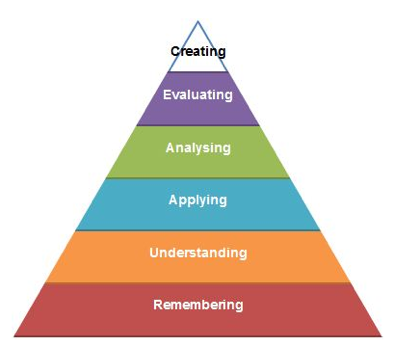Bloom’s Taxonomy is a teaching strategy developed in 1956 by Benjamin Bloom outlining a series of learning categories, from remembering to creating; each category builds on the mastery of the previous one. The original six categories of Bloom’s Taxonomy were revised slightly in 2000 to reflect 21st century relevance and now list Remembering, Understanding, Applying, Analyzing, Evaluating and Creating. Even though preschool children are emergent readers and writers, they can learn science through all the levels of Bloom’s Taxonomy with a few simple read-alouds, well-chosen questions and hands-on activities.

Remembering: can the student recall or remember the information?
Understanding: can the student explain ideas or concepts?
Applying: can the student use the information in a new way?
Analyzing: can the student distinguish between the different parts?
Evaluating: can the student justify a stand or decision?
Creating: can the student create new product or point of view?
Bloom Taxonomy Teaching Approach Example in Star America
Our Teacher read aloud the information during circle time. Simple picture books or short videos that tell about the life cycle of the butterfly or the seasons of the year are usually short and brightly illustrated to keep our children’s attention.
Help the children remember the basic information — the first stage of Bloom’s Taxonomy — by repeating it and asking them to repeat it back to you. Have children list the stages of the butterfly cycle or the seasons of the year, for example. Describe a stage of the butterfly life cycle or characteristics of a season for the children to identify.
Ask children specific questions about the subject to increase understanding. In the butterfly example, show the children a picture of a caterpillar or find different stages of the butterfly life cycle in a butterfly garden and ask children to identify the stage and what stage will it become next. Instruct children to observe the weather to identify which season it is now and which season comes next.
Have children apply what they’ve learned. Put pictures of the butterfly life cycle in random order and have children re-order the pictures correctly. Have children draw accurate representations of the season of the year, demonstrating that the children can apply what they’ve learned.
Provide opportunities for the children to analyze the information. Present information on the life cycle of the moth and ask children to compare and contrast the moth and the butterfly cycle. Have children describe the similarities and differences in the landscape between different seasons.
Ask questions that allow children to evaluate the information and draw conclusions. Why do butterflies lay their eggs on the underside of plant leaves? Why are butterflies attracted to certain plants? Why the trees do leaves change colors in autumn? Why does it snow in winter?
Instruct children to create something new based on all of the information they explored in the lesson. Have children create a fictional story based on the life of a butterfly or design a butterfly garden. Instruct children to design a new tool for removing snow in the winter or all-season clothing.


